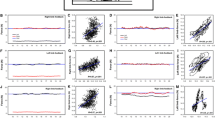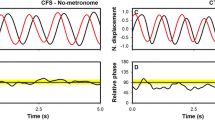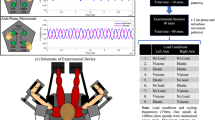Abstract
The current investigation was designed to examine the influence of inherent and incidental constraints on the stability characteristics associated with bimanual and social coordination. Individual participants (N = 9) and pairs of participants (N = 18, 9 pairs) were required to rhythmically coordinate patterns of isometric forces in 1:1 in-phase and 1:2 multi-frequency patterns by exerting force with their right and left limbs. Lissajous information was provided to guide performance. Participants performed 13 practice trials and 1 test trial per pattern. On the test trial, muscle activity from the triceps brachii muscles of each arm was recorded. EMG–EMG coherence between the two EMG signals was calculated using wavelet coherence. The behavioral data indicated that individual participants performed the 1:1 in-phase pattern more accurately and with less variability than paired participants. The EMG coherence analysis indicated significantly higher coherence for individual participants than for the paired participants during the 1:1 in-phase pattern, whereas no differences were observed between groups for the 1:2 coordination pattern. The results of the current investigation support the notion that neural crosstalk can stabilize 1:1 in-phase coordination when contralateral and ipsilateral signals are integrated via the neuromuscular linkage between two effectors.







Similar content being viewed by others
Data availability
Data available on request from the authors.
References
Barral J, Debû B, Rival C (2006) Developmental changes in unimanual and bimanual aiming movements. Dev Neuropsychol 29:415–429
Barral J, De Pretto M, Debû B, Hauert CA (2010) Activation and inhibition of bimanual movements in school-aged children. Human Physiol 36:47–57
Baweja HS, Patel BK, Neto OP, Christou EA (2011) The interaction of respiration and visual feedback on the control of force and neural activation of the agonist muscle. Hum Mov Sci 30(6):1022–1038
Bingham GP (2004) A perceptually driven dynamical model of bimanual rhythmic movement (and phase perception). Ecol Psychol 16:45–53
Bingham GP, Schmidt RC, Zaal FTJM (1999) Visual perception of relative phasing in human limb movements. Percept Psychophys 61:246–258
Bingham GP, Hughes K, Williams MM (2008) The coordination patterns observed when two hands reach-to-grasp separate objects. Exp Brain Res 184:283–293
Black DP, Riley MA, McCord CK (2007) Synergies in intra- and interpersonal interlimb rhythmic coordination. Mot Control 11:348–373
Boonstra TW, van Wijk BCM, Praamstra P, Daffertshofer A (2009) Corticomuscular and bilateral EMG coherence reflect distinct aspects of neural synchronization. Neurosci Lett 463:17–21
Boyles J, Panzer S, Shea CH (2012) Increasingly complex bimanual multi-frequency coordination patterns are equally easy to perform with on-line relative velocity feedback. Exp Brain Res 216:515–525
Brown P (2000) Cortical drives to human muscle: the Piper and related rhythms. Prog Neurobiol 60:97–108
Buchanan JJ, Park JH, Shea CH (2006) Target width scaling in a repetitive aiming task: switching between cyclical and discrete units of action. Exp Brain Res 175:710–725
Cardoso de Oliveira S (2002) The neuronal basis of bimanual coordination: recent neurophysiological evidence and functional models. Acta Psychol 110:139–159
Carson RG, Kelso JAS (2004) Governing coordination: behavioural principles and neural correlates. Exp Brain Res 154:267–274
Carson RG, Byblow WD, Abernethy B, Summer JJ (1996) The contribution of inherent and incidental constraints to intentional switching between patterns of bimanual coordination. Hum Mov Sci 15:55–589
Carson RG, Riek S, Smethurst CJ, Párraga JFL, Byblow WD (2000) Neuromuscular-skeletal constraints upon the dynamics of unimanualand bimanual coordination. Exp Brain Res 131:196–214
Cattaert D, Semjen A, Summers JJ (1999) Simulating a neural cross-talk model for between-hand interference during bimanual circle drawing. Biol Cybern 81:343–358
Chen YT, Li S, Magat E, Zhou P, Li S (2018) Motor overflow and spasticity in chronic stroke share a common pathophysiological process: analysis of within-limb and between-limb EMG–EMG coherence. Front Neurol 9:795
Cohen L (1971) Synchronous bimanual movements performed by homologous and non-homologous muscles. Percept Mot Skills 32 (2):639–644
Degallier S, Ijspeert A (2010) Modeling discrete and rhythmic movements through motor primitives: a review. Biol Cybern 103(4):319–338
Desrochers PC, Brunfeldt AT, Kagerer FA (2020) Neurophysiological Correlates of Adaptation and Interference during Asymmetrical Bimanual Movements. Neuroscience 432:30–43
Dideriksen JL, Negro F, Falla D, Kristensen SR, Mrachacz-Kersting N, Farina D (2018) Coherence of the surface EMG and common synaptic input to motor neurons. Front Hum Neurosci 12:207
Dumas G, de Guzman GC, Tognoli E, Kelso JA (2014) The human dynamic clamp as a paradigm for social interaction. Proc Natl Acad Sci USA 111(35):E3726–E3734
Gorman JC, Crites MJ (2015) Learning to tie well with others: bimanual versus intermanual performance of a highly practiced skill. Ergonomics 58:680–697
Grinsted A, Jevrejeva S, Moore J (2004) Application of the cross wavelet transform and wavelet coherence to geophysical time series. Nonlinear Process Geophys 11:561–566
Grosse P, Brown P (2003) Acoustic startle evokes bilaterally synchronous oscillatory EMG activity in the healthy human. J Neurophysiol 90:1654–1661
Guiard Y (1993) On Fitts’s and Hooke’s laws: simple harmonic movement in upper-limb cyclical aiming. Acta Psychol 82:139–159
Guiard Y (1997) Fitts’ law in the discrete vs. cyclical paradigm. Hum Mov Sci 16:97–131
Helmuth LL, Ivry RB (1996) When two hands are better than one: reduced timing variability during bimanual movements. J Exp Psychol Hum Percept Perform 22(2):278–293
Heuer H, Kleinsorge T, Spijkers W, Steglich W (2001) Static and phasic cross-talk effects in discrete bimanual reversal movements. J Mot Behav 33:67–85
Ivry RB, Richardson TC (2002) Temporal control and coordination: the multiple timer model. Brain Cogn 48:117–132
Kagerer FA, Summers JJ, Semjen A (2003) Instabilities during antiphase bimanual movements: are ipsilateral pathways involved? Exp Brain Res 151:489–500
Kelso JAS (1995) Dynamic patterns: the self-organization of the brain and behavior. MIT Press, Cambridge
Kelso JAS, Case P, Holroyd T, Horvath E, Rączaszek J, Tuller B, Ding M (1995) Multistability and metastability in perceptual and brain dynamics. Ambiguity Mind Nat 64:159–184
Kelso JAS, Fink PW, DeLaplain CR, Carson RG (2001) Haptic information stabilizes and destabilizes coordination dynamics. P Roy Soc Lond B Bio 268:1207–1213
Kennedy DM, Wang C, Shea CH (2013) Reacting while moving: influence of right limb movement on left limb reaction. Exp Brain Res 230:143–152
Kennedy DM, Boyle JB, Rhee J, Shea CH (2015) Rhythmical bimanual force production: homologous versus non-homologous muscles. Exp Brain Res 233:1917–2195
Kennedy DM, Wang C, Panzer S, Shea CH (2016) Continuous scanning transitioning through the attractor landscape. Neurosci Lett 610:66–72
Kennedy DM, Rhee J, Shea CH (2016) Symmetrical and asymmetrical influences on force production in 1:2 and 2:1 bimanual force coordination tasks. Exp Brain Res 234:287–300
Kennedy DM, Boyle JB, Wang C, Shea CH (2016) Bimanual force control: cooperation and interference. Psychol Res 80:34–54
Kennedy DM, Rhee J, Jimenez J, Shea CH (2017) The influence of asymmetric force requirements on a multi-frequency bimanual coordination task. Hum Mov Sci 51:125–137
Kostrubiec V, Dumas G, Zanone PG, Kelso JA (2015) The virtual teacher (VT) paradigm: learning new patterns of interpersonal coordination using the Human Dynamic Clamp. PLoS ONE 10(11):e0142029
Kovacs AJ, Shea CH (2011) The learning of 90 degrees continuous relative phase with and without Lissajous feedback: external and internally generated bimanual coordination. Acta Psychol 136:311–320
Kovacs AJ, Buchanan JJ, Shea CH (2009) Using scanning trials to assess intrinsic coordination dynamics. Neurosci Lett 455:162–167
Kovacs AJ, Buchanan JJ, Shea CH (2009) Bimanual 1:1 with 90 degrees continuous relative phase: difficult or easy! Exp Brain Res 193:129–136
Kovacs AJ, Buchanan JJ, Shea CH (2010a) Impossible is nothing: 5:3 and 4:3 multi-frequency bimanual coordination. Exp Brain Res 201:249–259
Kovacs AJ, Buchanan JJ, Shea CH (2010b) Perceptual and attentional influences on continuous 2:1 and 3:2 multi-frequency bimanual coordination. J Exp Psychol Hum Percept Perform 36:936–954
Kovacs AJ, Wang Y, Kennedy DM (2020) Accessing interpersonal and intrapersonal coordination dynamics. Exp Brain Res 238:17–27
Lum SP, Lehman SL, Reinkensmeyer DJ (1995) The bimanual lifting rehabilitator: an adaptive machine for therapy of stroke patients. IEEE Trans Rehabil Eng 3(2):166–174. https://doi.org/10.1109/86.392371.
Maki Y, Wong KFK, Sugiura M, Ozaki T, Sadato N (2008) Asymmetric control mechanisms of bimanual coordination: an application of directed connectivity analysis to kinematic and functional MRI data. Neuroimage 42:1295–1304
Marteniuk RG, Mackenzie CL, Baba DM (1984) Bimanual movement control—information-processing and interaction effects. Q J Exp Psychol 36:335–365
Marzullo ACM, Neto OP, Ballard KJ, Robin DA et al (2010) Neural control of the lips differs for young and older adults following a perturbation. Exp Brain Res 206:319–327
Murphy DL (2001) Endoscopic suturing and knot tying: theory into practice. Ann Surg 234:607
Neto OP, Pinto IRCA, Pinto O Jr (2013) The relationship between thunderstorm and solar activity for Brazil from 1951 to 2009. J Atmos Solar Terr Phys 98:12–21
Oldfield RC (1971) The assessment and analysis of handedness: the edinburgh inventory. Neuropsychologia 9:97–113
Oullier O, Kelso JAS (2009) Social coordination, from the perspective of coordination dynamics. Encyclop Complexity Syst Sci 19:8198–8213
Patil G, Nalepka P, Kallen RW, Richardson MJ (2020) Hopf bifurcations in complex multiagent activity: the signature of discrete to rhythmic behavioral transitions. Brain Sci 10(8):536
Pereira R, Freire IV, Cavalcanti CV, Luz CP, Neto OP (2012) Hand dominance during constant force isometric contractions: evidence of different cortical drive commands. Eur J Appl Physiol 112(8):2999–3006
Puttemans V, Wenderoth N, Swinnen SP (2005) Changes in brain activation during the acquisition of a multifrequency bimanual coordination task: from the cognitive stage to advanced levels of automaticity. J Neurosci 25:4270–4278
Richardson MJ, Marsh KL, Schmidt RC (2005) Effects of visual and verbal interaction on unintentional interpersonal coordination. Hum Move Sci 26:867–891
Richardson MJ, Marsh KL, Isenhower RW, Goodman JRL, Schmidt RC (2007) Rocking together: dynamics of intentional and unintentional interpersonal coordination. J Exp Psychol Hum Percept Perform 31:62–79
Ridderikhoff A, Peper CL, Beek PJ (2005) Unraveling interlimb interactions underlying bimanual coordination. J Neurophysiol 94:3112–3125
Riek S, Carson RG, Byblow WD (1992) Spatial and muscular dependencies in bimanual coordination. J Hum Movement Stud 23:251–265
Schmidt RC, O’Brien B (1997) Evaluating the dynamics of unintended interpersonal coordination. Ecol Psychol 9:189–206
Schmidt RC, Carello C, Turvey MT (1990) Phase transitions and critical fluctuations in the visual coordination of rhythmic movements between people. J Exp Psychol Hum Percept Perform 16:227–247
Schmidt RC, Fitzpatrick P, Bienvenu M, Amazeen PG (1998) A comparison of intra- and interpersonal interlimb coordination. J Exp Psychol Hum Percept Perform 24:884–900
Schmidt RC, Fitzpatrick P, Carson R, Margeche J (2011) Understanding social motor coordination. Hum Move Sci 30:834–845
Scholz JP, Kelso JAS (1989) A quantitative approach to understanding the formation and change of coordinated movement patterns. J Motor Behav 21:122–144
Semjen A, Summers JJ, Cattaert D (1995) Hand coordination in bimanual circle drawing. J Exp Psychol Hum Percept Perform 21:1139–1157
Shea CH, Buchanan JJ, Kennedy DM (2016) Perception and action influences on discrete and reciprocal bimanual coordination. Psychon Bull Rev 23:361–386
Summers J (2002) Practice and training in bimanual coordination tasks: strategies and constraints. Brain Cogn 48:166–178
Summers JJ, Todd JA, Kim YH (1993) The influence of perceptual and motor factors on bimanual coordination in a polyrhythmic tapping task. Psychol Res 55:107–115
Summers JJ, Ford SK, Todd JA (1993) Practice effects on the coordination of the 2 hands in a bimanual tapping task. Hum Movement Sci 12:111–133
Summers JJ, Maeder S, Hiraga CY, Alexander JR (2008) Coordination dynamics and attentional costs of continuous and discontinuous bimanual circle drawing movements. Hum Move Sci 27:823–837
Swinnen SP (2002) Intermanual coordination: from behavioural principles to neural-network interactions. Nature Rev 3:350–361
Swinnen SP, Wenderoth N (2004) Two hands, one brain: cognitive neuroscience of bimanual Skill. Trends Cogn Sci 8:18–25
Swinnen SP, Lee TD, Verschueren S, Serrien DJ, Bogaerts D (1997) Interlimb coordination: learning and transfer under different feedback conditions. Hum Move Sci 16:749–785
Swinnen SP, Dounskaia N, Duysens J (2002) Patterns of bimanual interference reveal movement encoding within a radial egocentric reference frame. J Cogn Neurosci 14:463–471
Temprado JJ, Laurent M (2004) Attentional load associated with performing and stabilizing a between-persons coordination of rhythmic limb movement. Acta Psychol 115:1–16
Temprado J-J, Zanone P-G, Monno A, Laurent M (1999) Attentional load associated with performing and stabilizing preferred bimanual patterns. J Exp Psychol Hum Percept Perform 25(6):1579–1594
Torrence C, Compo GP (1998) A practical guide to wavelet analysis. Bull Am Meteorol Soc 79:61–78
Van Der Wel RPRD, Sternad D, Rosenbaum DA (2009) Moving the arm at different rates: slow movements are avoided. J Mot Behav 42:29–36
Walter CB, Swinnen SP (1990) Asymmetric interlimb interference during the performance of a dynamic bimanual task. Brain Cogn 14(2):185–200
Wang S, Wang H, Yue L (2008) A novel knot-tying approach for minimally invasive surgical robot systems. Int J Med Robot 4:268–276
Wang C, Kennedy DM, Boyle JB, Shea CH (2013) A guide to performing difficult bimanual coordination tasks: just follow the yellow brick road. Exp Brain Res 230:31–40
Wilson AD, Collins DR, Bingham GP (2005a) Perceptual coupling in rhythmic movement coordination: stable perception leads to stable action. Exp Brain Res 164:517–528
Wilson AD, Collins DR, Bingham GP (2005b) Human movement coordination implicates relative direction as the information for relative phase. Exp Brain Res 165:351–361
Author information
Authors and Affiliations
Corresponding author
Ethics declarations
Conflict of interest
The authors have not received any financial support in this study and declare no conflict of interest.
Additional information
Communicated by Francesco Lacquaniti.
Publisher's Note
Springer Nature remains neutral with regard to jurisdictional claims in published maps and institutional affiliations.
Rights and permissions
About this article
Cite this article
Wang, Y., Neto, O.P., Davis, M.M. et al. The effect of inherent and incidental constraints on bimanual and social coordination. Exp Brain Res 239, 2089–2105 (2021). https://doi.org/10.1007/s00221-021-06114-8
Received:
Accepted:
Published:
Issue Date:
DOI: https://doi.org/10.1007/s00221-021-06114-8




